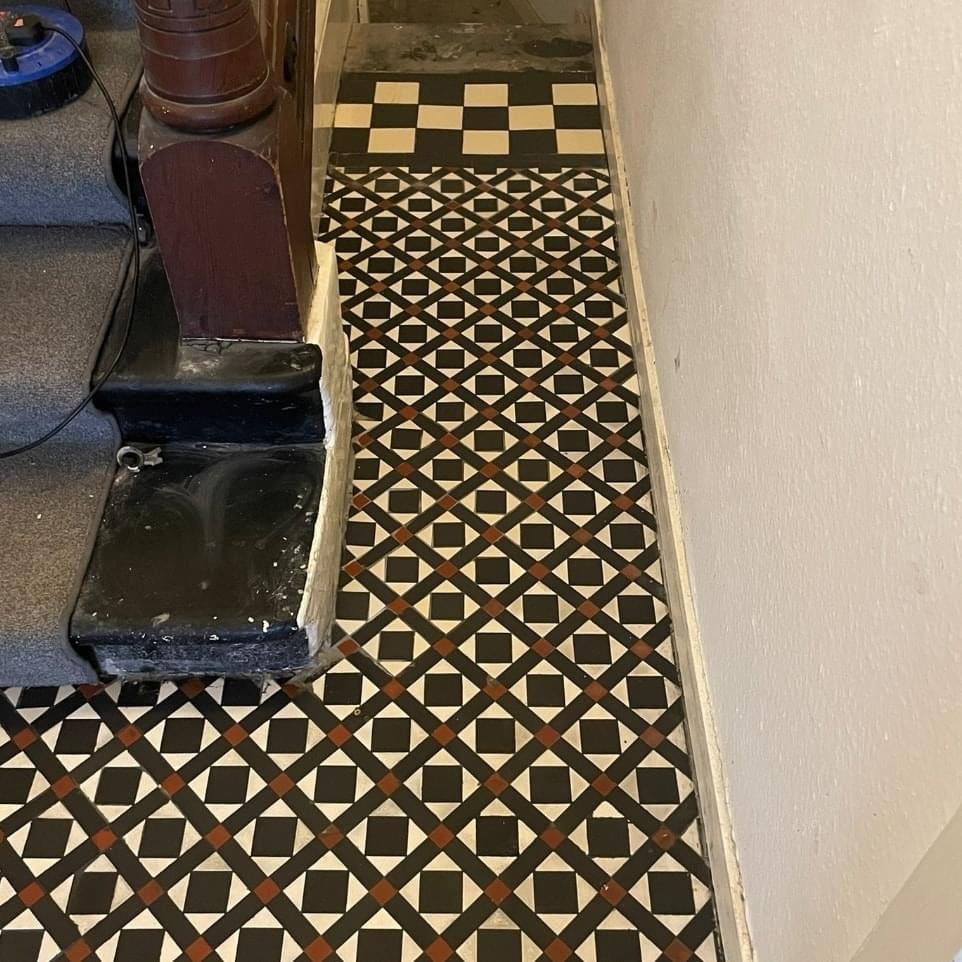The restoration of this Victorian Tiled hallway floor at a property in Glasgow’s West End proved to be quite a challenge. It had seen a long life and over that time it had numerous so called repair work carried out on it which basically resulted in bits of problematic floor being ripped out and back filled with concrete.

The current owner fully appreciated the value a fully restored period feature like an original tiled floor can add to a property so we were asked to pop round and provide a quote. Having restored numerous floors in the area I was happy to take on the job and provide a quote for the work. With the quote accepted and a date agreed I set about sourcing replacement tiles to match the existing.

Repairing a Victorian Tiled Hallway Floor
The first job was to lift all the tiles that were damaged or loose and move them to one side. This was followed by carefully knocking out all the areas of concrete back fill and screed from the original repairs. With the rubble cleared those areas were then levelled off with a mixture of cement board and self-levelling compound until the floor was level with the base of the original tiles.
 |
 |
While the repairs to the subfloor were setting the focus work moved on to salvaging as many of the original tiles as possible by grinding down the sides and backs to remove the old adhesive and cement. Once the tiles were cleaned and the sub floor had dried it was time to lay the tiles to match the original pattern. Many of the original tiles were unusable so a mixture of original and new reproduction Victorian tiles were used. Most of the tiles had to be hand cut down to size to fit.
 |
 |
The floor was then left to set and then re-grouted before moving on to the next step of restorative cleaning and sealing.
Restorative Cleaning and Sealing of an Original Victorian Hallway Floor
Old Victorian floors like this one do not have a damp proof membrane are as such are very susceptible to Efflorescent salt issues, so because of this I opted to go with a low moisture cleaning method.
This involved cleaned the tiles using a Tile Doctor Acid Gel which was worked in initially with a 100-grit diamond pad and then a 200-grit diamond pads fitted to a weighted rotary bonnet machine. This was carried out several times with all the slurry extracted using a wet vacuum. The advantages of Acid Gel is that an acidic cleaner will neutralise and alkaline salt, being a gel its very easy to control and finally its good at removing grout smears left over from tiling.
After a final inspection the floor was left to dry out overnight with the help of a fan to assist the drying before we could return to seal the tiles.
Sealing a Victorian Tiled Hallway Floor
I returned the following day to seal the floor checking first that it had dried using a damp meter. Once I was satisfied, three coats of Tile Doctor Colour Grow were applied to the tiles to enhance their appearance and protect then going forward.

I chose Colour Grow mainly because it’s a fully breathable sealer that will allow moisture to rise through the tile and evaporate at the surface. Use of a non-breathable sealer can lead to moisture becoming trapped under the floor where it could spread into the walls leading to rising damp.
 |
 |
The hallway was completely transformed by the time we had finished and as you can imagine our client was more than happy. So much so they even recommended us for another job and went to the extent of inviting them round to view the work.

Source: Victorian Hallway Tile Cleaning and Restoration Service in Glasgow
Covering Glasgow including Glasgow’s West End, Steven Thompson is your local Stone, Grout and Tile maintenance expert. Additionally Steven is an agent of Tile Doctor, the largest professional Tile, Stone and Grout restorative cleaning network in the UK. Tile Doctor has developed products and techniques to handle a multitude of issues surrounding tile, stone and grout, interior, exterior, domestic or commercial.